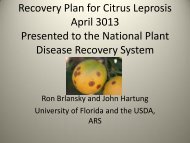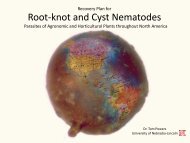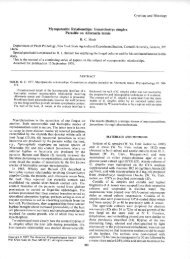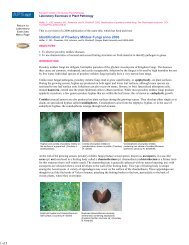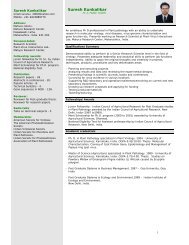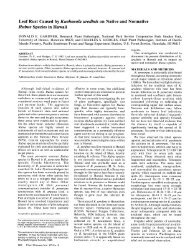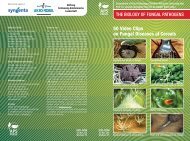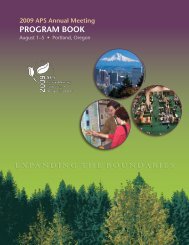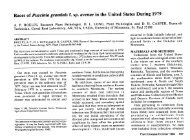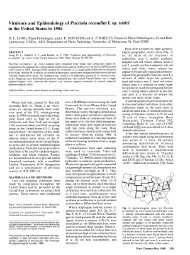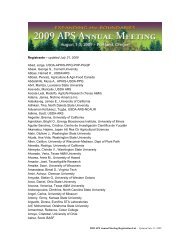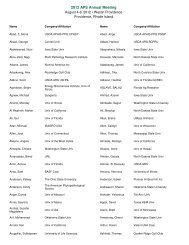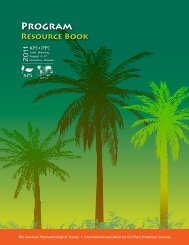view article - American Phytopathological Society
view article - American Phytopathological Society
view article - American Phytopathological Society
You also want an ePaper? Increase the reach of your titles
YUMPU automatically turns print PDFs into web optimized ePapers that Google loves.
abundance of pollen attached to a bee was recorded. Pollen 40-50 C compost was significantly reduced as compared to that<br />
concentration was not correlated to acquired Ice-minus population in media prepared with higher or lower temperature composts.<br />
densities. Bees acquired Ice-minus strains, non-nucleating Humicola isolates, unable to grow on PDA at 25 C, specifically<br />
bacteria, and Ice-plus bacteria from strawberry blossoms. The reduced efficacy of the biocontrol agent in paired biocontrol<br />
prevalence of strain GJP17BR2 on bees as compared to RGP36R2 was radish bioassays. Population development of T. hamatum 382 or<br />
inversely related to their relative population densities on of Rhizoctonia solani in media prepared with composts from<br />
blossoms from the same sampling period. Among the various temperatures did not differ. Results suggest that<br />
interpretations of this observation is the possibility that the compost process temperature impacts performance of Trichodermatwo<br />
strains may occupy spatially distinct habitats on strawberry fortified composts.<br />
blossoms that are reflected in the foraging habits of bees.<br />
134<br />
138<br />
INDUCED SYSTEMIC RESISTANCE TO PERONOSPORA TABACINA IN<br />
TENNESSEE 86 TOBACCO AND TISSUE CULTURE REGENERANTS OF INDUCED<br />
PLANTS. E. M. Nuckles and J. Kuc. Department of Plant<br />
Pathology, University of Kentucky, Lexington, KY 40546.<br />
INCREASE OF SCLEROTINIA SCLEROTIORUM AND VERTICILLIUM DAHLIAE<br />
FOLLOWING CERTAIN FOLIAGE FUNGICIDE SPRAYS ON POTATO. Gene 0.<br />
Easton, Washington State University, Irrigated Agriculture<br />
Research and Extension Center, Prosser, WA 99350.<br />
The tobacco cultivar Tennessee 86 is resistant to tobacco etch<br />
virus and tobacco vein mottling virus but is highly susceptible<br />
to tobacco mosaic virus and to blue mold caused by f.<br />
tabacina. Stem injection with sporangiospores of P. tabacina<br />
induced systemic resistance to blue mold in Tn 86. Resistance<br />
was expressed as a reduction in number, size, and sporulation<br />
of lesions. Tissue culture regenerants of Tn 86 plants steminjected<br />
with P. tabacina were protected against blue mold<br />
compared to regenerants from plants stem-injected with water.<br />
Induction of systemic resistance may provide a technology for<br />
rapidly introducing resistance to plants resistant to one or<br />
more pathogens.<br />
135<br />
Fungicides were sprayed on potato foliage in plots infested<br />
with Colletotricum coccodes (Cc), Sclerotinia sclerotiorum<br />
(Ss), and Verticillium dahliae (Vd). Visual ratings of<br />
symptoms and laboratory propagule counts after culture from<br />
stems showed: 1) Sclerotinia stem rot was not different from<br />
the control in plots sprayed with vinclozolin and thiophanate<br />
methyl in 1986-1988, 2) Sclerotinia stem rot was 5- to 10-fold<br />
greater in 1987 plots sprayed with chlorothalonil or Bravo C/N<br />
and their combination and in 1988 plots sprayed with<br />
chlorothalonil or fentin hydroxide and their combination than<br />
the control, 3) significantly more visible microsclerotia and<br />
stem propagules of Vd were present in 1988 plots treated with<br />
chlorothalonil or fentin hydroxide than in control plots, and<br />
4) Cc was not reduced or enhanced by any spray treatment.<br />
Application of fungicides did not alter tuber yield.<br />
FIELD PERFORMANCE AND GREENHOUSE ASSAY OF FUNGI FOR BIOCONTROL<br />
OF RESIDUE-BORNE PYRENOPHORA TRITICI-REPENTIS. W. F. Pfender,<br />
W. Zhang, and A. Nus. Dept. of Plant Pathology, Kansas State<br />
University, Manhattan, KS 66506.<br />
Candidate biocontrol fungi (grown in bran/millet seed culture)<br />
were applied to field plots containing Pyrenophora-infested<br />
winter wheat straw, with the goal of reducing ascocarp (primary<br />
inoculum) production by the pathogen in the residue.<br />
Limonomyces reduced ascocarp production by 86% and by 60-80%,<br />
respectively, in two years of field tests. Among fungi tested<br />
in one year only, an unidentified fungus significantly reduced<br />
ascocarp production, Laetisaria gave inconsistent results, and<br />
several fungi were ineffective. To screen candidate biocontrol<br />
fungi which under<br />
Pyrenophora-infested controlled conditions,<br />
straws a<br />
are method<br />
inoculated was developed<br />
with test<br />
in<br />
fungi and placed on a greenhouse bench with intermittent<br />
wetting cycles. Test conditions (straw and inoculum types,<br />
wetting periods) have been adjusted to give results consistent<br />
with those in field teats with selected fungi.<br />
136<br />
139<br />
PROTECTION OF POTATO FROM RHIZOCTNIA-CANKER WITH BINUCLEATE<br />
RHIZOCTONIA-LIKE FUNGI. A. Escande and E. Echandi, Department<br />
of Plant Pathology, North Carolina State University, Raleigh,<br />
27695-7616.<br />
Fourteen isolates of binucleate Rhizoctonia-like fungi (BN<br />
wer t e d as of bincl te agent s f ungiot BURo<br />
were studied as potential biocontrol agents for protection of<br />
potato from Rhizoctonia-canker in greenhouse and potato fields<br />
naturally infested with Rhizoctonia solani (AG-3). Eight of the<br />
BNR reduced incidence and severity ofi reoctonia-canker by an<br />
average of 78 and 85%, respectively, in greenhouse experiments.<br />
In<br />
severity<br />
the field,<br />
of Rhizoctonia-canker six of the eight BNR<br />
by an<br />
reduced<br />
average incidence<br />
of 43 and<br />
and<br />
41%,<br />
respectively. In a field heavily infested with R. solani,<br />
selected BNR and the fungicide Ttps 2.5D (thiophanate methyl)<br />
were equally protective of potato from Rhizoctonia-canker.<br />
Cultivars<br />
Burbank,<br />
Atlantic, Irish<br />
and<br />
Cobbler,<br />
Superior<br />
Kennebec, Norchip,<br />
were<br />
Russet<br />
equally protected from Rhizoctoniacanker<br />
by selected BNR under field conditions. Isolates of BNR<br />
have potential as biocontrol agents for protection of potato<br />
from Rhizoctonia-canker.<br />
COMPATIBILITY OF SOME COMMONLY USED SOIL DRENCH FUNGICIDES AND<br />
INSECTICIDES WITH THE BIOCONTROL AGENT GLIOCLADIUM VIRENS.<br />
J. C. Locke and R. D. Lumsden, Florist and Nursery Crops Lab.<br />
and Biocontrol of Plant Diseases Lab., Plant Sciences Institute,<br />
USDA-ARS, Beltsville, MD 20705.<br />
The interaction of the biocontrol agent Gliocladium virens with<br />
fungicides and insecticides, which can be used as soil drenches<br />
in bedding plant production systems, was investigated. The<br />
pesticides tested included: Aliette 8OW, Banrot 40WP, Benlate<br />
50W, Subdue 2E, Terraclor 75W, Truban 25EC, Diazinon AG4E, and<br />
Vydate L. The pesticides were evaluated for their effect on<br />
both proliferation of G. virens and the degree of damping-off<br />
control achieved against Pythium ultimum and Rhizoctonia solani<br />
on zinnia seedlings. None of the pesticides evaluated, except<br />
Benlate applied prior to introduction of the biocontrol agent,<br />
altered proliferation of the biocontrol agent in a soilless<br />
growing medium. Similarly, none of the pesticides decreased<br />
nor increased efficacy against either Pythium or Rhizoctonia.<br />
These results demonstrate the compatibility of this biocontrol<br />
agent with these pesticides at their labelled application rate.<br />
137<br />
INTERACTIONS BETWEEN TRICHoDERMA HAMATUM AND THERMOPHILIC FUNGI<br />
IN BARK COMPOST IN SUPPRESSION OF RHIZOCTONIA DAMPING-OFF. Y.<br />
R. Chung and H. A. J. Hoitink, Dept. of Plant Pathology, Ohio<br />
State Univ., Wooster, OH 44691.<br />
141<br />
EFFECTS OF DE-W TEMPERATURE, DEW PERIOD, AND REPEATED<br />
A white zone of microbial growth typically is present in<br />
compost piles where process temperatures range from 40-50 C.<br />
Humicola spp. were the predominant fungal taxa isolated from<br />
this zone. The ability of Trichoderma hamatum 382 to induce<br />
suppression to Rhizoctonia damping-off in media prepared with<br />
INOCULATIONS WITH PUCCINIA JACEAE ON YELLOW STARTHISTLE. A.<br />
R. BENNETT and W. L. BRUCKART, USDA-ARS, Ft. Detrick, Bldg.<br />
1301, Frederick, MD 21701.<br />
Puccinia jaceae was evaluated for biological control of yellow<br />
starthistle (YST, Centaurea solatitialis) in greenhouse<br />
1152 PHYTOPATHO LOGY



